Abstract
The husks of Xanthoceras sorbifolia Bunge (X. sorbifolia), as by-products of industrial production, have brought a severe burden to the environment and caused an enormous waste of resources. Bioactive triterpenoid saponins are rich in the husks. To reuse the husks and gain high-quality saponin products, saponin-oriented deep eutectic solvents (DESs), as an efficient and selective extraction strategy from X. sorbifolia husks, were designed for the first time. The enhancement of the extraction rate was investigated by screening solvents from acidic DESs and response surface methodology (RSM) optimization. As a result, the tetrapropylammonium bromide-lactic acid (TPMBr-La) was the most efficient DESs, with an extraction efficiency of up to 135% higher than 70% ethanol. A maximum extraction rate of 72.11 ± 0.61 mg Re/g dw was obtained under the optimized parameters. Scanning electron microscope graphs revealed that damage to the microstructure caused by DESs enhanced the extraction efficiency. Moreover, the recovery of total saponins with D101 macroporous resin was consistent with the pseudo-second-order kinetic model. Seven saponins were also identified by HPLC-MS analysis. Finally, TPMBr-La extracts exhibited 92.30 ± 1.10% DPPH radical scavenging rate at 100 μg/mL, and 92.20 ± 0.30% ABTS radical scavenging rate at 1200 μg/mL. Our current research proposes a selective and high-efficiency substitute for the extraction of saponins and might contribute to further DESs application in the recycling of by-products.
1. Introduction
Xanthoceras sorbifolia Bunge. (X. sorbifolia), belonging to the Sapindaceae family, is a native woody oil crop and has a planting history of more than 1000 years in China [1]. Due to its strong survival ability and adaptability [2], it is very suitable for planting in different climatic conditions and is also an ecological tree species and windproof against the sand. In recent decades, X. sorbifolia has attracted significant attention due to its promising potential for the production of high-quality biodiesel [3], pharmaceutical [4,5,6] and for ecological purposes [7] worldwide. As of 1998, the planting area of X. sorbifolia has been expanded to 800,000 hm2 [8]. At present, the development of biodiesel made from the seeds of the X. sorbifolia faces two major problems: the high number of low value-added wastes, such as fruit husks, produced in the production process, and the high cost of production. The mass of X. sorbifolia husks accounts for about 50% of the overall fruit mass [9]. The annual output of 100,000 tons of biodiesel requires the simultaneous consumption of 300,000 tons of X. sorbifolia seeds and the production of 300,000 tons of husks [10]. A high number of husks are discarded as waste or low-value-added products after biodiesel production every year, which are not effectively utilized, resulting in greater environmental pressure and the waste of resources. Research into the application of X. sorbifolia husks has focused on activated carbon [11] and feed. Due to the high saponins content in the husks, they are not conducive to the further development of feed. Therefore, the high-value utilization and deep processing of X. sorbifolia husks resources is not only a critical aspect for the alleviation of pressure on the environment and the reduction in production costs, but is also a breakthrough in the application of X. sorbifolia husks.
According to the research, barrigenol-like triterpenoid saponins are responsible for a range of pharmacological bioactivities, such as anti-tumor, anti-bacterial, anti-Alzheimer’s disease, anti-neuroinflammatory, and antioxidant properties [12,13,14]. Some barrigenol-like triterpenoid derivatives have also been applied to the treatment of encephaloedema [15]. X. sorbifolia husks are known for their abundant barrigenol-like triterpenoid saponins [16] and flavonoids; thus, it is clear that the X. sorbifolia husks have great utilization value and potential to develop high-value-added products, especially in the pharmaceutical industry. In recent years, some studies have focused on extracting saponins and other bioactive components from X. sorbifolia husks with conventional organic solvents, including ethanol, ethyl acetate, n-butanol, and ether [17]. However, traditional methods for the extraction of saponins from X. sorbifolia husks can result in low product purity, solvents residues, and high solvent consumption, which may cause serious environmental pollution and is not conducive to subsequent production. Eco-friendly and efficient methods have received extensive attention in recent years [18]. Considering the promising application of saponins from X. sorbifolia and the improved waste utilization rate, it is of great significance to seek new methods to achieve the high-efficiency extraction of saponins from X. sorbifolia husks and provide the extraction process with higher specificity.
Deep eutectic solvents (DESs) have been regarded as eco-friendly solvents that can substitute traditional organic solvents [19]. DESs are usually composed of hydrogen bond acceptors (HBAs) and hydrogen bond donors (HBDS) [20], with intermolecular hydrogen bonds and van der Waals interactions [21]. DESs have the advantages of being adjustable and biodegradable, with lower toxicity and low costs [22,23]. Tailor-made DESs have been applied to the selective extraction of bioactive components such as saponins, phenolics, and flavonoids. For example, acetic acids acting as HBDs in DESs have, in general, higher extraction efficiency for Agave sisalana and Ziziphus joazeiro due to the better solubilization of saponins [24]. Besides, the extraction rate of four steroidal saponins from Dioscoreae Nipponicae Rhizoma by natural DESs composed of chloride and malonic acid was higher, and the difference was significant compared to the methanol extraction [25]. Unfortunately, the oriented DESs approach towards extracting saponins from X. sorbifolia husks has not yet been investigated.
In the present study, we attempted to develop a selective and efficient approach to the extraction of total saponins from X. sorbifolia husks using saponins-oriented DESs for the first time. The difference in extraction efficiency and the possible mechanism were compared and determined. Moreover, extraction conditions were optimized by RSM. In addition, the recovery of saponins was carried out and the adsorption kinetics of macroporous resin was investigated. Finally, the saponins components of the extracts were determined by HPLC-ESI-MS analysis, and the antioxidant activities of the recovered TPMBr-La extracts were evaluated. Our findings provide a new strategy for the extraction of bioactive saponins from X. sorbifolia shells and the reuse of industrial by-product resources.
2. Materials and Methods
2.1. Plant Materials and Reagents
Xanthoceras sorbifolia Bunge. (NCBI-txid99658) husks were collected in October 2020 from Xanthoceras sorbifolia Bunge. standardized demonstration garden (Anqiu City, Weifang City, Shandong Province, China) and identified by associate professor Yu Wanwen (Co-Innovation Center for the Sustainable Forestry in Southern China, Nanjing Forestry University, Nanjing, China). The husks were dried in an oven at 40 °C to a constant weight, ground to 60 mesh with a pulverizer, and the powders were stored airtight.
All reagents were purchased from Macklin Biochemical Technology (Shanghai, China), unless otherwise specified. Total Antioxidant Capacity Assay Kit was purchased from Beyotime Biotechnology Ltd. (Shanghai, China). Macroporous resins were acquired from Yuanye Biotechnology Ltd. (Shanghai, China). Methyl alcohol (HPLC grade) was purchased from Anhui Tedia High-Purity Solvents Co., Ltd (Anhui, China).
2.2. Preparations of DESs
The preparation methods used in this study are reported in the literature [26]. The components of selected DESs were weighed at the 1:2 molar ratio in 50 mL centrifuge tubes and stirred at 90 °C until clear liquids were obtained. Fourteen types of DESs were prepared; their compositions and solvent codes listed in Table 1.

Table 1.
Composition and solvent code for the studied DESs.
2.3. Extraction of Total Saponins and Total Flavonoids
A total of 100 mg of X. sorbifolia powder and 2 mL of solvents with 30% water content (DESs, ethanol, and water) were added to a 10-mL centrifugal tube. The mixtures were shaken in a water-bath shaker at 60 °C for 30 min. Then, they were centrifuged at 12,000 rpm for 20 min to take the supernatant for determination.
2.4. Microstructure of Plant Material
The microstructure graphs of the X. sorbifolia powder treated by different solvents (water, ethanol, and TPMBr-La) were detected under thermal field emission scanning electron microscope JSM-7600F (Japan). The extracts were centrifuged to extract the precipitate and dried at low temperature in an oven. After being covered with gold, the microstructure was observed under a 3000-times magnification.
2.5. Optimal DESs Extraction Conditions for Total Saponins
Extraction variables and ranges were determined based on previous single-factor experiments (Supplement Materials Figure S1). Box-Behnken design experiment was conducted to optimize the extraction conditions. Extraction time (min), extraction temperature (°C), liquid-solid ratio (mL/g), and water content (%) were selected as independent variables, and the extraction rate of total saponins (mg/g) was used as the response value. Data were analyzed by software Design Expert 10.0.7. The obtained experimental data were consistent with the following second-order polynomial model:
where Y is the response value, Xi and Xj are the independent variables, β0 is a constant, βi, βii, βij are coefficients for linear, quadratic, and interaction parameters.
2.6. Determination of Total Saponins and Total Flavonoids Content
2.6.1. Determination of Total Saponins Content
The quantitative determination of total saponins was performed by the method previously reported in the literature [27]. Mixed 0.5 mL saponin extract with 0.2 mL 5% vanillin and 0.8 mL perchloric acid solution in a 10-mL test tube. The tubes were kept at 60 °C for 15 min and cooled for 2 min; the sample absorbances were measured at 552 nm. According to the relationship between absorbance value and different concentration of ginsenoside Re, the standard curve equation was acquired as follows: y = 14.043x + 0.0833 (0.2 < x < 1 mg/mL), R2 = 0.9997. The extraction rate was represented by mg ginsenoside Re equivalent (mg Re/g dw).
2.6.2. Determination of Total Flavonoids Content
The quantitative determination of total flavonoids was performed by the method previously reported in the literature [28]. A total of 1 mL extracted flavonoid samples were well-mixed with 0.3 mL of 5% NaNO2 solution; then, the sample was left for 6 min. Then, 0.3 mL of 10% Al(NO)3 solution was added, shook well, and placed in the sample for 6 min. Next, 4 mL of 4% NaOH solution was mixed, and the volume was fixed to 10 mL with 80% ethanol solution. Finally, samples were left at room temperature for 15 min and absorbances were measured at 510 nm. According to the relationship between absorbance value and different rutin concentrations, the standard curve equation was acquired as follows: y = 6.1043x + 0.0492 (0.04 < x < 1.5), R2 = 0.9994, indicating that the linearity of rutin was good in the concentration range from 0.04 to 1.5 mg/mL. This method can be used for the quantitative analysis of flavonoids; the extraction rate was represented by mg rutin equivalent (mg rutin /g dw), and calculated as follows:
2.7. Qualitative Analysis of Recovered Saponins Composition by HPLC-ESI-MS
Qualitative analysis of recovered saponins was performed on an HPLC chromatographic system (Agilent, Palo Alto, CA, USA) coupled with an LTQ-Qrbitrap mass spectrometer (Thermo Fisher Scientific, Waltham, MA, USA). The chromatographic with a ZORBAX SB-Aq C18 column (250 × 4.6 mm, 5 µm, Agilent, Palo Alto, CA, USA). The mobile phase were methyl alcohol (C) and 0.01% formic acid water (D); the flow rate was 0.4 mL/min. Gradient elution was conducted as follows: 0–30 min, 50–70% C; 30–60 min, 70–80% C; 60–70 min, 80–50% C. Injection volume was 10 µL and injection temperature was 30 °C. MS parameters were as follows: capillary temperature, 250 °C; auxiliary gas heater temperature, 200 °C; spray voltage, 1.5 kV; scanning range, 300–2000 m/z.
2.8. Recovery of Bioactive Saponins from TPMBr-La Extracts
2.8.1. Screening of Macroporous Resins
The recovery of saponins from DESs extract was carried out by adsorption and desorption with five kinds of macroporous resins, including DM301, NKA-9, D101, HPD100, and HP20. Saponins extracted by TPMBr-La were isolated and purified in accordance with the modified method [29]. A total of 2 g of the treated resin was weighed separately in a 50-mL conical bottle, and 10 mL of saponins solution extracted by TPMBr-La was added, before shaking at 25 °C with a speed of 80 rpm. The supernatant was sampled at regular intervals to detect the saponin content until the adsorption equilibrium was reached, before calculating the adsorption capacity (qe) and adsorption rate (Qar). The saturated macroporous resin was washed, and 10 mL of 70% ethanol solution was used as desorption solution, and shaken a shaking table at 25 °C with a speed of 80 rpm to desorption equilibrium, before calculating the desorption rate (Qdr).
where C0 and Ce are the concentration (mg/mL) of total saponins at the beginning and equilibrium of adsorption process, Va is the loading volume (mL) and W is the weight of macroporous resins (g). Cd (mg/mL) represents the concentration of saponins in the desorption eluent and Vd is the eluent volume (mL) in desorption experiments.
2.8.2. Study on Adsorption Kinetics of D101 Macroporous Resin
A total of 2 g of treated D101 macroporous resin was weighed into a 50 mL conical flask. Then, a total of 10 mL DESs extract was added, and shaken at 25 °C and 80 rpm for 7 h in a constant-temperature shaker. The supernatant was sampled at every 30 min to detect the saponin content until the adsorption equilibrium was reached. The adsorption rate and mechanism were studied by fitting the intra−particle diffusion, pseudo-first-order, and pseudo-second-order kinetic models. The linear equations of the three models are as follows:
where qe and q are adsorption capacity (mg/g) at the equilibrium and t min; ki, k1, and k2 represent the adsorption rate constants of intra particle diffusion, pseudo-first-order, and pseudo-second-order kinetic models; C is the kinetic constant of intra particle diffusion, mg/g.
2.9. Determination of Antioxidant Activity
2.9.1. DPPH Radical Scavenging Assay
DPPH radical scavenging assay was determined by this method with slight modification [30]. The sample was prepared into a series of concentrations with methanol. In brief, 100-µL sample solutions were mixed with the same volume of DPPH solution. The mixture was placed away from light for 30 min; then, the absorbances were read at 517 nm. The DPPH radical scavenging rate of samples was assessed in accordance with the following equation:
2.9.2. ABTS Radical Scavenging Assay
The ABTS radical scavenging capacity was determined by referring to the instructions of Total Antioxidant Capacity Assay Kit. ABTS could generate ABTS radical cations (ABTS+) in the presence of an oxidant. A total of 200 μL ABTS working solution and 10-μL diluted samples were mixed in a clear 96-well microplate. The microplate was allowed to stand for 6 min at room temperature and the absorbance was measured at 734 nm. The ABTS radical scavenging rate of the sample was calculated in accordance with Equation (9).
2.10. Statistical Analysis
Except for HPLC-ESI-MS analyses, all experiments were performed in triplicate. Data were expressed as mean ± standard deviation. The statistically significant differences (p < 0.05) were conducted by analysis of variance (ANOVA).
3. Results and Discussion
3.1. Design and Screening of Saponin−Oriented DESs
With the advantages of acidic DESs in saponin extraction [24], we selected lactic acid, malonic acid, glycolic acid, and malic acid as HBDs. Choline chloride, betaine, ethylamine hydrochloride, tetrapropylammonium bromide, and ethylene glycol were chosen as HBAs. To facilitate analysis, fourteen designed DESs were classed into five groups based on HBAs. In contrast with traditional organic solvents, the high viscosity of the DESs affected the mass transfer rate, so 30% water was added to the DESs to ease the viscosity [31]. Meanwhile, considering the difference in the extraction efficiency of DESs for saponins and flavonoids, flavonoids, as an important component in X. sorbifolia husks, were also chosen to estimate the specific and efficient DESs for saponins. The extraction rates of the total saponins and total flavonoids with different DESs groups and conventional efficient solvents, i.e., 70% ethanol and water are exhibited in Figure 1. It is indicated that the component of DESs extensively impacted the extraction efficiency for the total saponins and total flavonoids, respectively. As shown in Figure 1a, the Chcl-based DESs group had the highest overall extraction efficiency for saponins, followed by the TPMBr-based, Eacl-based, and Bet-based groups. The Eg-based group showed the lowest extraction efficiency for saponins. The extraction efficiency of most of the acidic DESs for saponins was higher than when using 70% ethanol and water, and this finding is in accordance with the previous report [32]. Among the 14 kinds of DESs, TPMBr-La (67.01 ± 0.57 mg Re/g dw) showed the highest extraction rate for saponins, up to 135% higher than the use of 70% ethanol (28.50 ± 0.02 mg Re/g dw) and 296% higher than the use of water (16.90 ± 0.60 mg Re/g dw). Moreover, Chcl-Ga, Bet-La, Eg-La, and Eacl-La also displayed an efficient extraction rate (60.72 ± 2.53 mg Re/g dw, 54.24 ± 1.99 mg Re/g dw, 51.49 ± 2.53 mg Re/g dw, and 51.14 ± 2.90 mg Re/g dw). Bromine ion can connect the hydroxyl H atom on saponins and the solvent, to reduce the spatial effect around saponins and form more hydrogen bonds [33]. The comprehensive score for TPMBr-La for the total saponins was optimal, which could be attributed to the growth in the number of hydrogen bonds and more stable average noncovalent interaction.
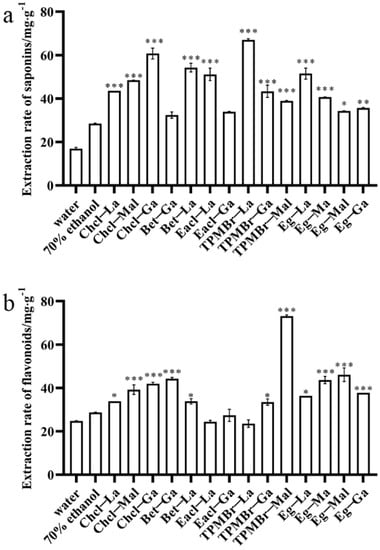
Figure 1.
The extraction rate of total saponins and total flavonoids from X. sorbifolia husks using different solvents: (a) the extraction rate of total saponins; (b) the extraction rate of total flavonoids. There is a significant difference when * p < 0.05, ** p < 0.01 and *** p < 0.001 versus 70% ethanol.
The overall extraction efficiency of the acidic DESs for total flavonoids was obviously lower than that for saponins. In Figure 1b, the Chcl-Ga, Bet-La, and Eg-La (41.99 ± 0.63 mg Rutin/g dw, 33.82 ± 1.22 mg Rutin/g dw, 36.36 ± 0.03 mg Rutin/g dw, respectively) showed a significant extraction efficiency rate for flavonoids. However, TPMBr-La (23.57 ± 3.40 mg Re/g dw) displayed a lower extraction efficiency for flavonoids, suggesting that TPMBr-La is selective for the extraction of saponins. Taken together, TPMBr-La was the best DESs to specificly extract bioactive saponins from X. sorbifolia and would be applied in the follow-up experiments.
3.2. Preliminary Extraction Mechanism for the Efficiency and Specificity of Saponins Extraction
To better understand why TPMBr-La was the most effective method for the extraction of saponins, the different extraction solvents, including water, 70% ethanol, and TPMBr-La, were investigated. The microstructure graphs of the X. sorbifolia powder before and after treatment using the above extraction solvents were recorded using thermal field emission scanning electron microscope. The X. sorbifolia powder without extraction displayed a flat and undamaged surface (Figure 2a), whereas the powders extracted by other solvents displayed different degrees of damage. The X. sorbifolia powder treated by water displayed many strip folds without crack (Figure 2b). The powder treated by ethanol and TPMBr-La showed visible pores and cracks, as shown in Figure 2c,d, respectively. Compared to the ethanol treatment, the TPMBr-La treatment showed more severe and pronounced damage. The damage was caused by the dissolution of cellulose and broken lignin after extraction with DES, which may be more conducive to the infiltration of DESs and the overflow of bioactive substances. This finding may account for the higher extraction efficiency of the DESs as compared to the organic solvent, which is consistent with the finding of polydatin extraction by DESs [34].
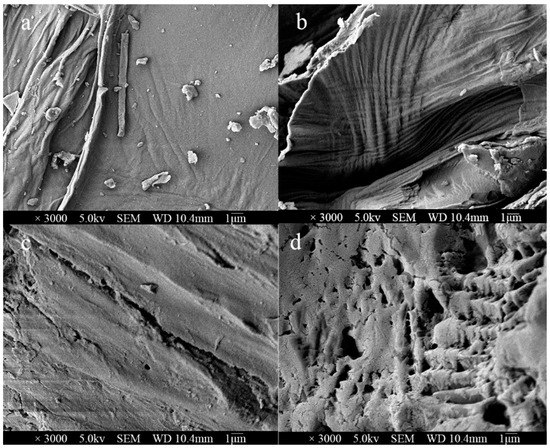
Figure 2.
The field emission scanning electron microscope images of X. sorbifolia powder: (a) X. sorbifolia crude drug powder; (b) X. sorbifolia powder extracted by water; (c) X. sorbifolia powder extracted by ethanol; (d) X. sorbifolia powder extracted by TPMBr-La.
3.3. Box-Behnken Design (BBD) Optimization
To assess the influence of four variables (extraction time, extraction temperature, liquid-solid ratio, and water content in the DESs) on the extraction efficiency of TPMBr-La from X. sorbifolia husks, a Box-Behnken design was conducted, and the levels of the factors are presented in Table 2. The experimental orders, levels of variables, and response values are shown in the Supplement Materials, Table S1. The quadratic regression equation for the extraction rate of total saponins (Y) and variables (A, B, C, and D) is as follows:
Y = 72.16 − 1.82A + 2.92B + 0.83C − 0.62D − 0.29AB + 0.83AC + 1.71AD − 0.29BC − 0.058BD + 0.21CD − 1.27A2 − 3.57B2 − 1.43C2 − 3.25D2

Table 2.
Independent factors and their levels.
The analysis of variance (ANOVA) for the regression model is displayed in Table 3. The p-value of the model was 0.0003 (p < 0.001), demonstrating that the model level was extremely significant. The coefficient of determination (R2) was 0.9616, and the adjusted R-square (Adj R2) was 0.8849, indicating that the experimental and predicted values correlate well. In addition, the p-value of the lack-of-fit value was not significant (0.9541), which showed that unknown factors had little interference with the test results. It can also be seen from the analysis of variance that the primary term, secondary term, and the interaction term of each factor had different effects on the extraction process. The impact degree of the independent variables was in the order of B > A > C > D. It was clear that the extraction temperature exhibited an extremely significant effect on the extraction rate (p < 0.0001). The p-values of the quadratic term coefficients A2, B2, C2, and D2 were less than 0.05, indicating that these factors had a significant impact on the extraction rate. However, the cross-product coefficients (AB, AC, BC, BD, and CD) were not significant (p > 0.05).

Table 3.
The ANOVA of the regression model.
The 3D response plots illustrated the interaction effects between the variables (Figure 3). The curve in the extraction temperature was the steepest, indicating the greatest effect on the extraction rate, and the curve of the water content was the flattest, indicating that the influence was the lowest. This conclusion is also consistent with the results of the analysis of variance. Figure 3a is used as an example of the analysis of the mutual effect of the extraction time and temperature on the extraction rate of total saponins. The increase in temperature could improve the extraction rate of total saponins, but a further increase in temperature led to a decrease in the extraction rate. This may be due to the increase in temperature, which decreased the viscosity of the deep eutectic solvents and improved the mass transfer efficiency. When the temperature is too high, the extracted saponins may be degraded, resulting in a reduction in the extraction efficiency. The highest point can be seen in the graph, suggesting that the extraction rate had the highest value. The optimum TPMBr-La conditions for the extraction of total saponins from X. sorbifolia were as follows: extraction time of 28 min, extraction temperature of 78 °C, liquid-solid ratios of 26 mL/g, and water content of 35%. The actual extraction rate under optimal conditions was 72.11 ± 0.61 mg Re/g dw, closely matching the predicted value of 73.06 mg Re/g dw. It is suggested that this model can simulate and predict the actual extraction of bioactive saponins from X. sorbifolia.

Figure 3.
Comprehensive score of the response surface of the total saponins extraction rate. (a) The interaction between extraction time and temperature; (b) the interaction between liquid–solid ratio and extraction time; (c) the interaction between extraction time and water content; (d) the interaction between liquid–solid ratio and extraction temperature; (e) the interaction between water content and extraction temperature; (f) the interaction between water content and liquid–solid ratio.
3.4. Recovery of Total Saponins and Kinetic Analysis of Adsorption Process
3.4.1. Screening of Macroporous Resins
For the efficient recovery of total saponins from TPMBr-La extract solution, we investigated the adsorption and desorption rates of NKA-9, DM301, D101, HPD100, and HP20 macroporous resins. As described in Figure 4, D101, DM301, and NKA-9 macroporous resin displayed a superior adsorption rate (91.41%, 89.62%, 89.34%, respectively), indicating that the total saponin in the TPMBr-La extract can be adsorbed well. In the process of desorption, the D101 macroporous resin showed a better desorption rate (77.74%) for total saponins. The reason that the desorption rate is not particularly high may be attributed to the water-soluble and nonvolatile properties of DESs. Therefore, D101 resin was used to recover total saponins from the TPMBr-La extract solution.
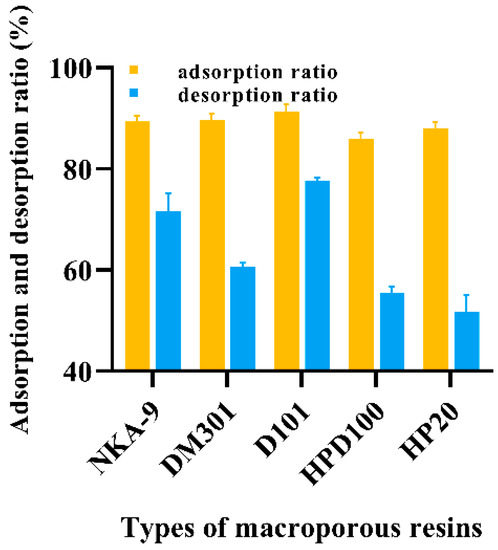
Figure 4.
Adsorption and desorption rates of different kinds of macroporous resins.
3.4.2. Kinetic Analysis of the Adsorption Process
To better understand the mechanisms of saponin adsorption on D101 macroporous resin, a kinetic analysis was conducted. The static adsorption kinetics of D101 macroporous resin on total saponins at 25 °C is shown in Figure 5a. For the first 60 min, the adsorption capacity qt significantly increased as the time continued to increase. After 60 min, the adsorption rate of the resin decreased, and the adsorption capacity increased slowly as the adsorption time increased. The equilibrium adsorption qt was the highest at 10.89 mg/g when the duration was 360 min.
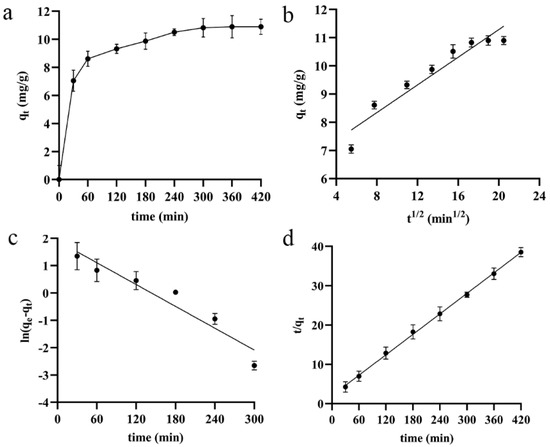
Figure 5.
D101 static adsorption kinetic curve of macroporous resin (a); intra-particle diffusion (b); pseudo-first-order (c); pseudo-second-order (d).
The adsorption process was analyzed by fitting the intra-particle diffusion, pseudo-first-order, and pseudo-second-order kinetic models. The three kinetic models fitted at 25 °C for total saponins on D101 resin are shown in Figure 5b–d. The kinetic equations of total saponin adsorption by the D101 resin and their related parameters are displayed in Table 4. C > 0 in the kinetic equation for intra-particle diffusion, suggesting that the adsorption rate of saponins partly depends on intra-particle diffusion and partly on the boundary layer diffusion [35]. The calculated values of the maximum adsorption capacity (qe calc) of the pseudo-first-order and pseudo-second-order models were 6.7201 and 11.5340 mg/g, respectively. The qe calc of the pseudo-second-order kinetic model was closer to the experimental qe value (10.90 mg/g), and the R2 (0.9991) was the highest; it seemed that the adsorption process of the D101 macroporous resin was fitted to the pseudo-second-order kinetic model.

Table 4.
Kinetic equations for saponins adsorption by the D101 resin.
3.5. Identification of Barrigenol-Like Saponins in the TPMBr-La Extracts
Triterpenoids saponins are the major components in X. sorbifolia husks, and their backbones include the oleanane-type, lupine-type, glyseian-type, cycloatene-type, and lanolin-type [15]. The barrigenol-like triterpenoid saponins are multiple hydroxylated oleanane-type [36]. It is reported that barrigenol-like triterpenoid saponins are not only abundant in the husks of X. sorbifolia, but also the main responsible active components.
To find the presence of barrigenol-like triterpenoid saponins that were recovered from the TPMBr-La extracts, we performed an HPLC-ESI-MS analysis in the positive ion mode to identify the chemical compositions. The total ion chromatogram (TIC) of the saponins is shown in Figure 6. Seven types of triterpenoid saponins were identified, and their chemical structures are presented in Figure 7.
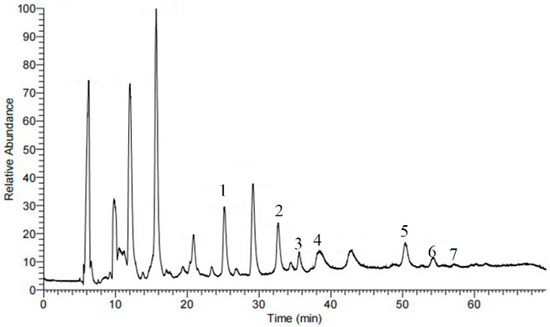
Figure 6.
Total ion chromatogram (TIC) 200–2000 m/z of the TPMBr-La-extract saponins of X. sorbifolia.
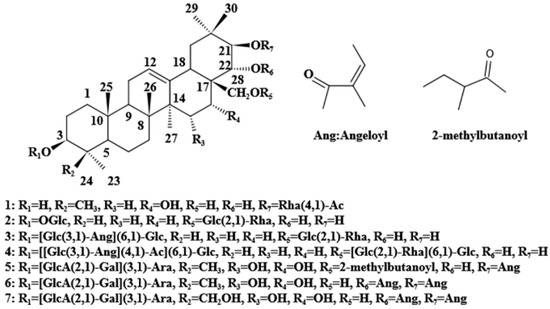
Figure 7.
Chemical structure of the saponins identified from X. sorbifolia husks.
As an example, xanthoceracide (6) was identified based on ionic fragments. The precursor ion m/z 1141.57 [M + H]+ and 1163.57 [M + Na]+ in the ESI(+) mode were given, and the molecular formula could be inferred to as C57H88O23. The cleavage behavior of the triterpenoid saponins in the positive mode of the ESI source was highly similar. Basically, glycosides were gradually lost at first to obtain the aglycone excimer ion peaks, such as m/z 693.84 and 493.89. Moreover, the successive loss of H2O and angeloyl occurred in order to obtain a series of glycoside fragments, such as m/z 593.28 and 342.93. Therefore, based on similar cleavage patterns and reports in the literature [37,38,39,40], other six triterpenoids saponins were identified as 16-O-acetyl-21-O-α-L-rhamnopyranosyl-β-barringtogenol C (1), 3-O-β-D-glucopyranosyl, 28-O-[α-L-rhamnol (1→2)]-β-D-gluc-opyranosyl-16-deoxybarringtogenol C (2), 3-O-[β-D-glucopyranosyl (1→6)] (3′-O-angeloyl)-β-D-glucopyranosyl-28-O-[α-L-rhamnosyl(1→2)]-β-D-glucopyranosyl-16-deoxybarringtogenol C (3), 3-O-(3-O-angeloyl-4-O-acetyl-6-O-β-D-glucopyranosyl)-β-D-glucopyranosyl-28-O-(2-α-L-rhamnopyranosyl-6-O-β-Dglucopyranosyl)-β-D-glucopyranosyl-16-deoxybarringtogenol C (4), xanifoliaY7 (5), and xanifolia Y2 (7). The concrete substances identified from the extracts are listed in Supplementary Materials Table S2. The identification of and research into barrigenol-like triterpenoids saponins in X. sorbifolia husks are beneficial to the further development and utilization of the saponin.
3.6. Evaluation of the Antioxidant Activity of the TPMBr-La Extracts
The saponins contained in the recovered extract of the ethanol from the husks of X. sorbifolia have been reported to have antioxidant activity [41]. Nevertheless, the impact of different extraction methods on the antioxidant activity of saponins is not clear. Thus, we evaluated the antioxidant properties of saponins extracted from X. sorbifolia using different methods (TPMBr-La, ethanol, and water) through a DPPH and ABTS free radical scavenging ability tests. Vitamin C (Vc) was considered as a positive control.
As shown in Figure 8, the DPPH and ABTS free radical scavenging activity of TPMBr-La extracts displayed dose-dependence. When the concentration of the TPMBr-La extract was in the range of 25~100 μg/mL, the DPPH scavenging ability enhanced with the increasing concentration. When the concentration of the extract was 100~800 μg/mL, its scavenging ability no longer improved and tended to remain stable. The DPPH free-radical scavenging activity of the TPMBr-La extracts at 100 μg/mL exhibited the highest DPPH inhibition (92.30 ± 1.10%), significantly higher than that of ethanol extraction (26.74 ± 1.00%). As can be seen from Table 5, the TPMBr-La extracts gave the lowest DPPH inhibition IC50 value of 36.54 ± 0.46 μg/mL (p < 0.001) compared to the ethanol extracts, which had the IC50 value of 215.35 ± 6.90 μg/mL (p < 0.05), while Vc demonstrated an intermediate DPPH inhibition with the IC50 value of 59.43 ± 0.53 μg/mL (p < 0.001). The ABTS free-radical scavenging rate of the TPMBr-La extracts (92.20 ± 0.30%) at 1200 μg/mL was significantly higher than that of ethanol extracts (69.89 ± 0.07%). ABTS inhibition IC50 value of the TPMBr-La extracts was 541.13 ± 0.03 μg/mL (p < 0.001), which was lower than the IC50 value of the ethanol extracts 855.25 ± 1.66 μg/mL (p < 0.001). In sum, the TPMBr-La extracts exhibited superior antioxidant activity, which may be due to the high content of saponins in the DESs solvent-extraction and the improved bioavailability through enhanced antioxidant membrane transport [42].
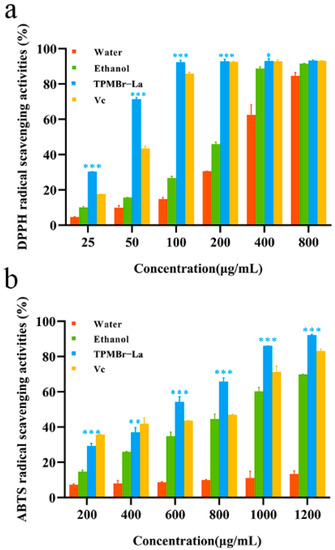
Figure 8.
Determination of the DPPH and ABTS radical scavenging capacity of bioactive saponins recovered from water, ethanol, and TPMBr-La. There is a significant difference when * p < 0.05, ** p < 0.01, and *** p < 0.001 versus ethanol.

Table 5.
The IC50 value of DPPH and ABTS free-radical scavenging activity.
4. Conclusions
The husks of X. sorbifolia, as bulky by-products of industrial production, have brought a severe burden to the environment and caused an enormous waste of resources. Additionally, X. sorbifolia husks are known for their abundant triterpenoid saponins, particularly barrigenol-like triterpenoid saponins resources, which are responsible for a range of pharmacological bioactivities. For the high-value utilization of X. sorbifolia husks, we attempted to design eco-friendly and saponins-oriented DESs to extract the bioactive saponins from X. sorbifolia husks. TPMBr-La, as an efficient and selective solvent, was obtained from the fourteen prepared acidic DESs. The saponins’ extraction efficiency was up to 135% higher than when using 70% ethanol. The extraction mechanism showed that severe damage to the treated plant powders may be more conducive to the infiltration of DESs and the overflow of bioactive substances, to give rise to efficient extraction. The extraction conditions were optimized by Box-Behnken design RSM, and a maximum extraction rate of 72.11 ± 0.61 mg Re/g dw was obtained under the optimized extraction varies. The resulting D101 exhibited good adsorption and desorption abilities and its adsorption kinetic was compatible with the pseudo-second-order kinetic equation. The recovered TPMBr-La extracts exhibited significantly superior efficacy in scavenging the DPPH and ABTS radicals compared with the use of ethanol, indicating the probable enrichment effect of DESs on saponins. In summary, this study has demonstrated that acidic DESs are efficient and selective solvents for the high-value utilization of X. sorbifolia husks. Our findings also contribute to a new approach to the further application of DESs in the recycling of by-products.
Supplementary Materials
The following are available online at https://www.mdpi.com/article/10.3390/antiox11040736/s1, Figure S1: Five independent variables were determined for the preliminary range by single factor experiment. Table S1: The experimental orders, levels of variables, and response values in Box-Behnken design. Table S2: Characterization of chemical compounds in TPMBr-La extracts from X. sorbifolia husks powder by HPLC-ESI-MS in positive mode.
Author Contributions
Conceptualization and original draft preparation, J.C.; validation, G.W.; formal analysis, L.W.; funding acquisition, F.C.; supervision, Y.J.; project administration, L.Z. All authors have read and agreed to the published version of the manuscript.
Funding
This work was research was funded by the Jiangsu “333” project of cultivation of high-level talents (Grant No. BRA2015317), and the 11th Six Talents Peak Project of Jiangsu Province (Grant No. 2014-JY-011).
Institutional Review Board Statement
Not applicable.
Informed Consent Statement
Not applicable.
Data Availability Statement
The data presented in this study are available in this manuscript.
Acknowledgments
Thanks to Shandong Worth Agriculture Company for providing raw materials of Xanthoceras sorbifolia fruit husks.
Conflicts of Interest
The authors declare no conflict of interest.
References
- Yao, Z.Y.; Qi, J.H.; Yin, L.M. Biodiesel production from Xanthoceras sorbifolia in China: Opportunities and challenges. Renew. Sustain. Energy Rev. 2013, 24, 57–65. [Google Scholar] [CrossRef]
- Jin, H.; Zou, J.X.; Li, L.L.; Bai, X.L.; Zhu, T.; Li, J.B.; Xu, B.C.; Wang, Z. Physiological responses of yellow-horn seedlings to high temperatures under drought condition. Plant Biotechnol. Rep. 2020, 14, 111–120. [Google Scholar] [CrossRef]
- Li, X.F.; Hou, S.L.; Su, M.; Yang, M.F.; Shen, S.H.; Jiang, G.M.; Qi, D.M.; Chen, S.Y.; Liu, G.S. Major Energy Plants and Their Potential for Bioenergy Development in China. Environ. Manag. 2010, 46, 579–589. [Google Scholar] [CrossRef]
- Hu, D.; Cui, Y.J.; Zhang, J. Nervonic acid amends motor disorder in a mouse model of Parkinson’s disease. Transl. Neurosci. 2021, 12, 237–246. [Google Scholar] [CrossRef] [PubMed]
- Yang, X.; Gao, X. Advances in studies on chemical constituents and pharmacological effects of Xanthoceras sorbifolia. Northwestern Pharm. J. 2004, 5, 235–237. [Google Scholar]
- Chai, X.; Zhang, J.W.; Li, S.H.; Cheng, Q.S.; Qin, M.M.; Yang, C.Y.; Gao, J.L.; Huang, H.B. Xanthoceraside induces cell apoptosis through downregulation of the PI3K/Akt/Bcl-2/Bax signaling pathway in cell lines of human bladder cancer. Indian J. Pathol. Microbiol. 2021, 64, 294–301. [Google Scholar] [CrossRef] [PubMed]
- Chen, X.Q.; Lei, Z.L.; Cao, J. Traditional uses, phytochemistry, pharmacology and +current uses of underutilized Xanthoceras sorbifolium bunge: A review. J. Ethnopharmacol. 2022, 283, 114747. [Google Scholar] [CrossRef]
- Wang, H.D. Research Progress on chemical constituents and comprehensive utilization of Xanthoceras sorbifolia Bunge. Chin. Wild Plant Resour. 1998, 17, 13–16. [Google Scholar]
- Liu, X.X.; Yang, X.A.; Qv, C.; Wu, Z.; Yang, B.Z.; Wang, L.H.; Zou, L.B. Effects of Extracts from the Pericarp of Xanthoceras sorbifolia Bunge on Learning and Memory Obstacle. Tradit. Chin. Drug Res. Clin. Pharmacol. 2007, 18, 23–25. [Google Scholar] [CrossRef]
- Wu, W.J.; Li, B.S. Extraction of saponins from Xanthoceras sorbifolia husks by foam separation. J. Zhejiang Agric. Sci. 2010, 4, 816–819. [Google Scholar]
- Zhang, X.T.; Hao, Y.N.; Wang, X.M.; Chen, Z.J. Adsorption of iron(III), cobalt(II), and nickel(II) on activated carbon derived from Xanthoceras Sorbifolia Bunge hull: Mechanisms, kinetics and influencing parameters. Water Sci. Technol. 2017, 75, 1849–1861. [Google Scholar] [CrossRef] [PubMed]
- Li, Y.Y.; Xiang, Z.; Cui, H.; Xiao, H.; Kang, T.G.; Dou, D.-Q.; Kuang, H.X. Two new oleanane-type saponins from the husks of Xanthoceras sorbifolia Bunge. Nat. Prod. Res. 2013, 27, 208–214. [Google Scholar] [CrossRef] [PubMed]
- Rong, W.; Ding, K.; Guo, S.; Xie, F.; Li, Q.; Bi, K. Metabolomics analysis of Xanthoceras sorbifolia husks protection of rats against Alzheimer’s disease using liquid chromatography mass spectrometry. J. Chromatogr. B Anal. Technol. Biomed. Life Sci. 2019, 1126, 121739. [Google Scholar] [CrossRef] [PubMed]
- Zhang, Y.; Ma, J.N.; Ma, C.L.; Qi, Z.; Ma, C.M. Simultaneous quantification of ten constituents of Xanthoceras sorbifolia Bunge using UHPLC-MS methods and evaluation of their radical scavenging, DNA scission protective, and alpha-glucosidase inhibitory activities. Chin. J. Nat. Med. 2015, 13, 873–880. [Google Scholar] [CrossRef]
- Zhang, X.; Zhang, S.; Yang, Y.R. Natural barrigenol-like triterpenoids: A comprehensive review of their contributions to medicinal chemistry. Phytochemistry 2019, 161, 41–74. [Google Scholar] [CrossRef] [PubMed]
- Yang, F.; Han, S.S.; Nan, Y. Progress in research and development of Xanthoceras Sorbifolia. China J. Chin. Mater. Med. 2021, 46, 4334–4343. [Google Scholar] [CrossRef]
- Wang, L.H.; Chen, W. Optimization of Extraction Technology of Xanthoceraside from Xanthoceras sorbifolia Bunge Husks by Orthogonal Test. Food Sci. 2009, 30, 58–60. [Google Scholar]
- Cunha, S.C.; Fernandes, J.O. Extraction techniques with deep eutectic solvents. TrAC Trends Anal. Chem. 2018, 105, 225–239. [Google Scholar] [CrossRef]
- Ruesgas-Ramon, M.; Figueroa-Espinoza, M.C.; Durand, E. Application of deep eutectic solvents (DES) for phenolic compounds extraction: Overview, challenges, and opportunities. J. Agric. Food Chem. 2017, 65, 3591–3601. [Google Scholar] [CrossRef]
- Martins, M.A.R.; Pinho, S.P.; Coutinho, J.A.P. Insights into the Nature of Eutectic and Deep Eutectic Mixtures. J. Solut. Chem. 2019, 48, 962–982. [Google Scholar] [CrossRef] [Green Version]
- Shishov, A.; Bulatov, A.; Locatelli, M.; Carradori, S.; Andruch, V. Application of deep eutectic solvents in analytical chemistry: A review. Microchem. J. 2017, 135, 33–38. [Google Scholar] [CrossRef]
- Cui, Q.; Liu, J.Z.; Wang, L.T.; Kang, Y.F.; Meng, Y.; Jiao, J.; Fu, Y.J. Sustainable deep eutectic solvents preparation and their efficiency in extraction and enrichment of main bioactive flavonoids from sea buckthorn leaves. J. Clean. Prod. 2018, 184, 826–835. [Google Scholar] [CrossRef]
- Wojeicchowski, J.P.; Ferreira, A.M.; Abranches, D.O.; Mafra, M.R.; Coutinho, J.A.P. Using COSMO-RS in the design of deep eutectic solvents for the extraction of antioxidants from Rosemary. ACS Sustain. Chem. Eng. 2020, 8, 12132–12141. [Google Scholar] [CrossRef]
- Ribeiro, B.D.; Zarur Coelho, M.A.; Marrucho, I.M. Extraction of saponins from sisal (Agave sisalana) and jua (Ziziphus joazeiro) with cholinium-based ionic liquids and deep eutectic solvents. Eur. Food Res. Technol. 2013, 237, 965–975. [Google Scholar] [CrossRef]
- Yang, G.Y.; Song, J.N.; Chang, Y.Q.; Wang, L.; Zheng, Y.G.; Zhang, D.; Guo, L. Natural Deep Eutectic Solvents for the Extraction of Bioactive Steroidal Saponins from Dioscoreae Nipponicae Rhizoma. Molecules 2021, 26, 2079. [Google Scholar] [CrossRef] [PubMed]
- Duan, L.; Zhang, W.H.; Zhang, Z.H.; Liu, E.H.; Guo, L. Evaluation of natural deep eutectic solvents for the extraction of bioactive flavone C-glycosides from Flos Trollii. Microchem. J. 2019, 145, 180–186. [Google Scholar] [CrossRef]
- Li, T.T.; Zhang, H.; Wu, C.E. Screening of Antioxidant and Antitumor Activities of Major Ingredients from Defatted Camellia oleifera Seeds. Food Sci. Biotechnol. 2014, 23, 873–880. [Google Scholar] [CrossRef]
- Jia, Z.; Wang, Z.; Xu, C.; Liang, J.; Wei, B.; Wu, D.; Zhu, S. Study on poly (methyl methacrylate)/carbon nanotube composites. Mater. Sci. Eng. A 1999, 271, 395–400. [Google Scholar] [CrossRef]
- Shen, D.; Labreche, F.; Wu, C.; Fan, G.; Li, T.; Dou, J.; Zhu, J. Ultrasound-assisted adsorption/desorption of jujube peel flavonoids using macroporous resins. Food Chem. 2022, 368, 130800. [Google Scholar] [CrossRef]
- Thaipong, K.; Boonprakob, U.; Crosby, K.; Cisneros-Zevallos, L.; Byrne, D.H. Comparison of ABTS, DPPH, FRAP, and ORAC assays for estimating antioxidant activity from guava fruit extracts. J. Food Compos. Anal. 2006, 19, 669–675. [Google Scholar] [CrossRef]
- Wang, M.; Wang, J.; Zhang, Y.; Xia, Q.; Bi, W.; Yang, X.; Chen, D.D.Y. Fast environment-friendly ball mill-assisted deep eutectic solvent-based extraction of natural products. J. Chromatogr. A 2016, 1443, 262–266. [Google Scholar] [CrossRef] [PubMed]
- Shi, X.L.; Yang, Y.; Ren, H.X.; Sun, S.Y.; Mu, L.; Chen, X.; Wang, Y.Z.; Zhang, Y.; Wang, L.; Sun, C.H. Identification of multiple components in deep eutectic solvent extract of Acanthopanax senticosus root by ultra-high-performance liquid chromatography with quadrupole orbitrap mass spectrometry. Phytochem. Lett. 2020, 35, 175–185. [Google Scholar] [CrossRef]
- Fu, X.; Belwal, T.; He, Y.; Xu, Y.; Li, L.; Luo, Z. UPLC-Triple-TOF/MS characterization of phenolic constituents and the influence of natural deep eutectic solvents on extraction of Carya cathayensis Sarg. peels: Composition, extraction mechanism and in vitro biological activities. Food Chem. 2022, 370, 131042. [Google Scholar] [CrossRef] [PubMed]
- Sun, B.; Zheng, Y.L.; Yang, S.K.; Zhang, J.R.; Cheng, X.Y.; Ghiladi, R.; Ma, Z.; Wang, J.; Deng, W.W. One-pot method based on deep eutectic solvent for extraction and conversion of polydatin to resveratrol from Polygonum cuspidatum. Food Chem. 2021, 343, 28498. [Google Scholar] [CrossRef]
- Saeed, T.; Naeem, A.; Din, I.U.; Farooq, M.; Khan, I.W.; Hamayun, M.; Malik, T. Synthesis of chitosan composite of metal-organic framework for the adsorption of dyes; kinetic and thermodynamic approach. J. Hazard. Mater. 2022, 427, 127902. [Google Scholar] [CrossRef] [PubMed]
- Wang, D.; Su, D.; Li, X.Z.; Liu, D.; Xi, R.G.; Gao, H.Y.; Wang, X.B. Barrigenol triterpenes from the husks of Xanthoceras sorbifolia Bunge and their antitumor activities. RSC Adv. 2016, 6, 27434–27446. [Google Scholar] [CrossRef]
- Li, W.; Li, X.; Yang, J.; Meng, D.L.; Li, N. Two new triterpenoid saponins from the carpophore of Xanthoceras sorbifolia Bunge. J. Asian Nat. Prod. Res. 2008, 10, 260–264. [Google Scholar] [CrossRef]
- Chan, P.K.; Zhao, M.; Che, C.T.; Mak, E. Cytotoxic acylated triterpene saponins from the husks of Xanthoceras sorbifolia. J. Nat. Prod. 2008, 71, 1247–1250. [Google Scholar] [CrossRef]
- Li, J.; Zu, Y.G.; Fu, Y.J.; Yang, Y.C.; Li, S.M.; Li, Z.N.; Wink, M. Optimization of microwave-assisted extraction of triterpene saponins from defatted residue of yellow horn (Xanthoceras sorbifolia Bunge) kernel and evaluation of its antioxidant activity. Innov. Food Sci. Emerg. Technol. 2010, 11, 637–643. [Google Scholar] [CrossRef]
- Ling, J.H.; Liu, L.L.; Wang, Y.X.; Li, Z.Y.; Liu, R.; Li, Q.; Wang, Y.; Yang, B.Z.; Chen, X.H.; Bi, K.S. Characterization and quantification of the triterpenoids in different parts of Xanthoceras sorbifolia by HPLC-ESI-MS. J. Pharm. Biomed. 2011, 55, 259–264. [Google Scholar] [CrossRef]
- Zhang, Y.L.; Xiao, H.F.; Shi, H.X.; Song, Z.X.; Tang, Z.S. Antioxidant activity of fruit Shells of Xanthoceras sorbifolia and screening of active components inhibiting proliferation of HepG2 cell lines. Mod. Chin. Med. 2017, 19, 1572–1574. [Google Scholar] [CrossRef]
- Mrsan, A.; Nadpal, J.; Stupar, A.; Pojic, M.; Mandic, A.; Verpoorte, R.; Choi, Y.H. The perspectives of natural deep eutectic solvents in agri-food sector. Crit. Rev. Food Sci. Nutr. 2020, 60, 2564–2592. [Google Scholar] [CrossRef]
Publisher’s Note: MDPI stays neutral with regard to jurisdictional claims in published maps and institutional affiliations. |
© 2022 by the authors. Licensee MDPI, Basel, Switzerland. This article is an open access article distributed under the terms and conditions of the Creative Commons Attribution (CC BY) license (https://creativecommons.org/licenses/by/4.0/).